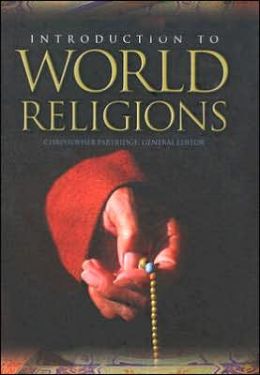Christopher Partridge: Introduction to World Religions
 Christopher Partridge, General Editor, Introduction to World Religions, (Minneapolis: Fortress, 2005), 495 pages.
Christopher Partridge, General Editor, Introduction to World Religions, (Minneapolis: Fortress, 2005), 495 pages.
Here is a great introductory overview of the major religions of the world that will be an invaluable resource for scholars, clergy, interested laity, and just about anyone seeking accessible, understandable information regarding the rich religious diversity of humanity. An update of an earlier standard, Introduction to World Religions is lavishly illustrated, well organized, and has helpful charts and graphs depicting important chronological and geographical development or liturgical practices. Sidebar quotes accompanying text discussions are often unusually poignant. A particular strength of this book is that it contains not only expert analyses but also lay testimonies about experiences of devotees. This feature helps readers move beyond the laboratory analyses of academic or intellectual observation to empatheticaly experience an insider’s view of each faith. A wide range of scholarly contributors nonetheless also skillfully relate their subjects. The editorial staff is to be especially commended for an excellent job assuring that the unevenness that can often occur with works of multiple authorships just does not happen. Accordingly, though this book is broad, it is certainly not shallow. Yet it has been kept to a manageable size and has a readable style. For computer buffs a nicely done compact disc is included that makes cruising the contents even easier.
The book begins with a brief discussion of what religion in general really is, and how its contemporary study as a genre has been influenced by the insights of the social sciences. Ancient and indigenous religions are then presented before going on to discuss Hinduism, Jainism, Buddhism, Sikhism, Zoroastrianism, Judaism, Christianity, Islam, the religions of East Asia, and Bahá’í Faith. Each faith is respectfully allowed to speak for itself and stand on its own. A generally similar format is applied to each faith, moving from a historical overview to sacred writings, beliefs, rituals and festivals, familial and societal life, and each religion’s status and state in the modern world. Enough flexibility is built into the work, however, to allow today’s world in relation to currents and concerns of postmodernism, globalization, new religious movements, politics and terrorism, and more. A “Rapid Fact Finder” in the back of the book and a thorough index serve well to define key concepts and locate their discussion within the text body.
An important note is needed. Introduction to World Religions is not a book on theology of religions. It does an exceptional job helping us make sense of the make up of so many religions. It does not help us at all to make sense of their meaning from the perspectives of our own respective traditions. For one thing, that is obviously quite outside the purpose of the present book, which is dedicated primarily to overviewing the facts of the faiths. For another, theology of religions, or making sense of other religions in light of one’s own religion, is an extensive process well beyond its scope. A quick look at some of the major ways in which the religions relate to one another, however, would have been helpful. For readers who are devotees of a particular discipline this study is not merely an academic or intellectual exercise but impinges upon personal spirituality in possibly intense ways. An attack of ambiguity or uncertainty is perhaps an understandable and not uncommon occurrence when reading a book in which radically different world views are set side by side. What are we to think of each other, or to feel toward each other? How are we to act with one another? General editor Christopher Partridge has done some good work on theology of religions (e.g., “A Hermeneutic of Hopefulness: A Christian Personalist Response to the Inclusivism of Clark Pinnock”, pp. 184-219, in Tony Gray & Christopher Sinkinson, Reconstructing Theology: A Critical Assessment of the Theology of Clark Pinnock, Waynesboro, GA: Paternoster, 2000), as have several other contributors. Might not these resources have been mined? Interreligious relations should be addressed responsibly in a work bringing so many starkly contrasting conceptions of ultimate reality before us. Frustration about this missing factor is actually aggravated by maximally effective analyses of religion and the religions in relations with a myriad of other fields—cultural, economical, philosophical, political, technological–everything except each another. To work in a few pages or even paragraphs on theological reflections on and responses to the reality of religious pluralism seems pertinent also. Nevertheless, this work does indeed move toward mutual understanding and that too is a major first step forward.
Category: In Depth, Winter 2007


